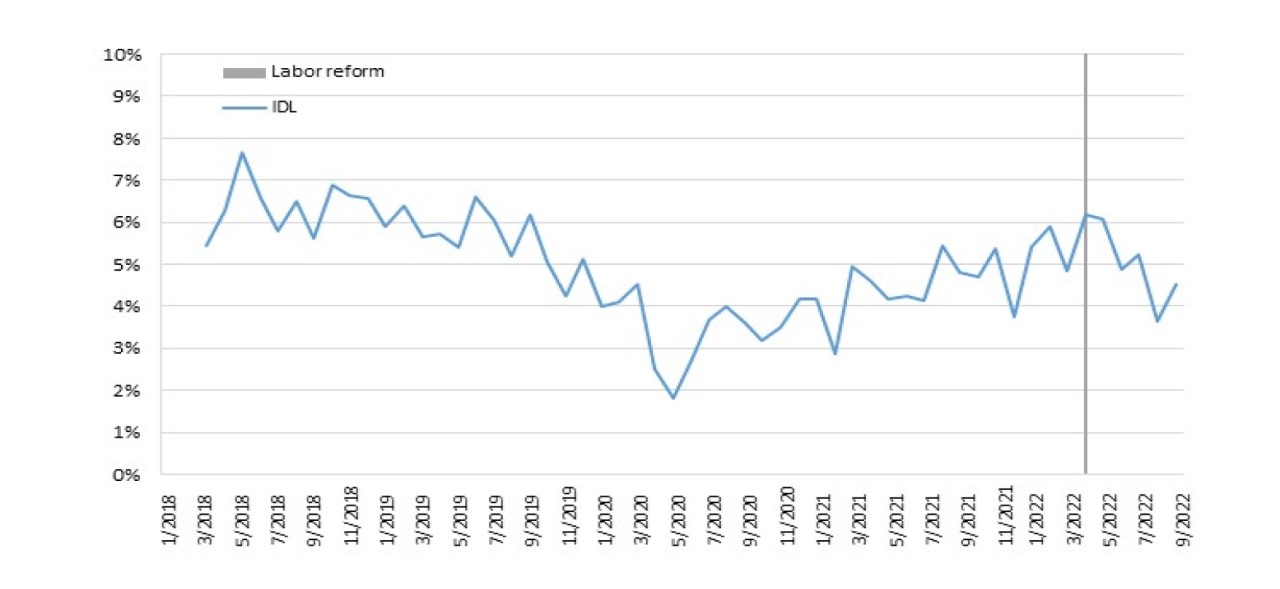
IESE Insight
Spain's labor market: fewer temporary contracts in the mix
Permanent contracts are more common but less stable since Spain's latest labor reform, according to IESE's Labor Dynamism Index of November 2022.
- In September 2022, new permanent contracts represented nearly 70% of all contracts signed in Spain — a sharp contrast to what was seen from 2018 to 2021, when new temporary contracts represented 90% of the total.
- Although permanent contracts are now more common, they show greater instability than they did before Spain’s labor reform of December 2021.
- The Labor Dynamism Index, prepared by IESE and Cegid, came in at 4.5% in September 2022, representing a decrease in Spain’s labor dynamism since April 2022.
On March 30, 2022, Spain’s latest labor reform (officially, Royal Decree-Law 32/2021) came into effect. Simply put, this labor reform curbed the use of temporary contracts for workers. So, what impact has this reform had on labor mobility so far? The 15th edition of the Labor Dynamism Index, prepared annually by IESE and Cegid, starts to answer this question.
The latest Labor Dynamism Index shows decreasing job mobility
The Labor Dynamism Index measures the percentage of employees and positions that have experienced a change in work status that is unrelated to the outright creation or elimination of jobs. By ignoring job gains and losses, the indicator aims to focus on personnel substitutions instead.
In September 2022, this indicator registered a value of 4.5%, slightly below the last period analyzed, April 2022, when it was around 6%.
Changes in the Labor Dynamism Index since 2018

Identifying new labor trends
What’s behind this downward trend? According to Marta Elvira, IESE professor and director of the Labor Dynamism Index, there are two main factors to consider: labor reform and the macroeconomic context. As she puts it: "the decrease in labor dynamism coincides with the implementation of the labor reform, as well as with a change in the national macroeconomic framework,” which, she notes, has been impacted by inflation, monetary policymakers’ reactions to inflation as well as geopolitical uncertainty. “Taken together, all of this increases uncertainty, which may be reflected in a less dynamic labor market,” she sums up.
That said, Elvira notes that Spain’s recent labor reform “has had important effects on the types of labor contracts used. Now, permanent full-time and permanent part-time contracts are used for most new hires.” But there’s more to the labor story in 2022, as a few salient points reveal.
Greater stability in the labor market overall. The report details that employment in permanent full-time and permanent part-time contracts has increased significantly this year, coinciding with a drop in temporary full-time and temporary part-time offers. In September 2022, new permanent contracts represented nearly 70% of all contracts signed in Spain — a sharp contrast to what was seen from 2018 to 2021, when new temporary contracts represented 90% of the total. This shift to permanent jobs looks poised to continue.
Less stability in permanent contracts. At the same time, contract termination rates reveal a potentially troubling trend. From 2018 through 2021, the terminations of temporary contracts accounted for 75% of all terminations observed. But, in September 2022, terminations affected permanent and temporary contracts roughly equally. Therefore, the stability of permanent contracts seems to have decreased.
Permanent contracts looking more temporary. As Elvira observes: “our detailed company-level data suggests that the average tenure of permanent contracts has decreased. It will be necessary to carefully evaluate whether the change in the nature of the contracts means greater stability for workers in the long term.”
What does the future of work hold?
Further observations of job stability and personnel changes will be necessary as employers’ contracting practices evolve. For María José Fraile, HR director of Cegid for Iberia and Latin America, "what our data seems to point to is that, regardless of the permanent/temporary contracting model, there is a tendency to carry out contracts that, in one way or another, have a fixed duration and not a long-term one.”
Methodology, very briefly
The Labor Dynamism Index is prepared annually by IESE and Cegid, a global provider of business management solutions in the cloud. Its 15th edition has been carried out using the data of 80,500 workers in 243 companies, from January 2018 to September 2022. New to this edition is a microdata analysis of worker contracts in 17 sectors, with the aim of evaluating whether there is a relationship between the types of contracts and labor dynamism.
Download the 15th edition of the Labor Dynamism Index report (in Spanish).
